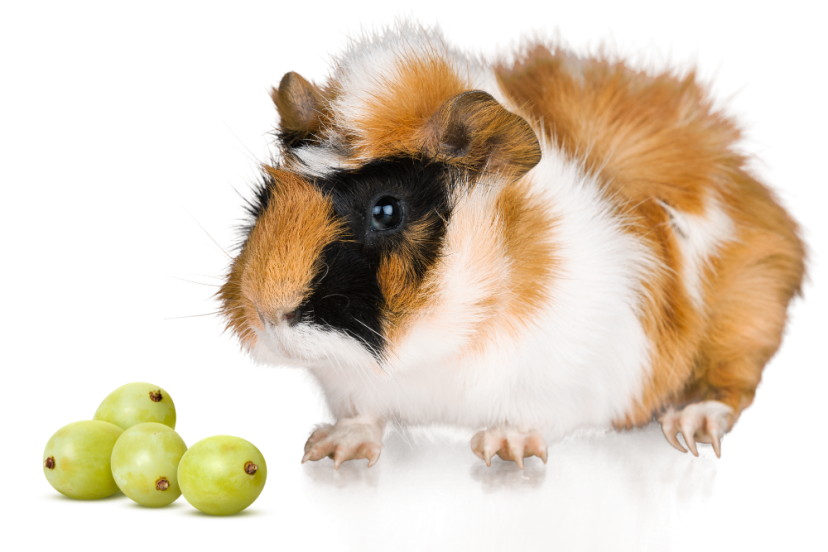Can Guinea Pigs Eat Grapes?
Ah, grapes! They’re juicy, sweet, and a personal favorite snack of mine. But can our little furry companions, guinea pigs, enjoy them as much as we do? Today we’ll be exploring the question “Can guinea pigs eat grapes?”. We’ll take a look at the benefits, potential risks, and how to ensure your guinea pig can safely enjoy this delicious fruit.
Grapes: A Fruitful Discussion
We know that not everything we humans munch on is safe for our pets. So, when it comes to guinea pigs and grapes, what’s the deal?
Nutritional Benefits of Grapes
When you pop a juicy grape into your mouth, have you ever paused to think about the explosion of nutrients that come with it? Grapes aren’t just delicious; they’re a treasure trove of health benefits, some of which can be beneficial for our adorable guinea pigs too.
1) Vitamin C Galore: Just like humans, guinea pigs cannot produce vitamin C on their own. This vitamin is vital for a plethora of functions, including collagen production, which plays a pivotal role in healing wounds. Grapes provide a lovely dose of this essential vitamin, helping boost your guinea pig’s immune system.
2) Antioxidants: These tiny fruits are packed with antioxidants, particularly flavonoids and tannins. While the science behind how these antioxidants specifically benefit guinea pigs is still budding, we know that in general, antioxidants can combat harmful free radicals in the body, supporting overall health.
3) Hydration: Grapes have a high water content. Especially on a warm day, feeding your cavy a grape or two can help keep them hydrated. Proper hydration plays a role in almost all bodily functions, from digestion to temperature regulation.
4) Minerals: Grapes also contain small amounts of vital minerals like potassium and magnesium. Potassium is essential for nerve function and muscle contractions, while magnesium supports bone health and enzymatic reactions.
5) Fiber: The dietary fiber in grapes aids in digestion. A good digestive process is paramount for guinea pigs as it helps in nutrient absorption and maintaining a healthy weight.
However, as with all good things, moderation is key. The natural sugars found in grapes, while a source of energy, can be a double-edged sword. Too much can be detrimental, leading to obesity and other health issues. So, while grapes can be a delightful treat bursting with nutrients, they should be offered in careful amounts to ensure your cavy gets the benefits without the drawbacks. Always strike a balance, and your guinea pig can enjoy the bounties of this succulent fruit!
Potential Risks with Grapes
When answering the question “Can guinea pigs eat grapes?”, it’s not only about the health benefits. While grapes come with a variety of nutritional benefits, it’s essential to be aware of their potential risks, especially when introducing them to your guinea pig’s diet.
Let’s dive into some cautionary tales of grapes and guinea pigs.
1) Sugar Content: Grapes, despite their many health benefits, are naturally high in sugar. While a grape here and there might not seem like much to us, for a guinea pig, it can quickly add up. A diet high in sugar can lead to obesity, digestive troubles, and even diabetes in guinea pigs. It’s essential to keep grape treats sporadic and monitor your pet’s weight and health.
2) Choking Hazard: Whole grapes can pose a choking risk, especially for younger or smaller guinea pigs. It’s crucial to cut the grapes into smaller, manageable pieces to make it easier and safer for your cavy to consume.
3) Pesticides and Chemicals: If you’re sourcing grapes from a store, there’s a potential risk of pesticide and chemical residue on the skin. Always wash grapes thoroughly, or even better, opt for organic grapes to minimize the risk of introducing harmful substances to your guinea pig’s system.
4) Seeded Grapes: Some grapes come with seeds, which can be a choking hazard. Moreover, there’s uncertainty about the digestibility of these seeds for guinea pigs. Always ensure you’re offering seedless grapes or have removed the seeds beforehand.
5) Overconsumption: Like all treats, grapes should be given in moderation. Overfeeding can lead to an imbalance in your guinea pig’s diet, causing them to miss out on other essential nutrients from their primary food sources. This can result in unnecessary vet visits which can make the cost of having a Guinea Pig higher.
How to Safely Serve Grapes to Your Guinea Pig
Ensuring that grapes are a safe and delightful treat for your guinea pig requires a bit of preparation and awareness. If you’re considering introducing grapes into your furry friend’s diet, here are some steps to ensure they get the most enjoyment out of this juicy treat without any hitches:
1) Wash Thoroughly: Begin by washing the grapes properly. This helps to remove any potential pesticides, dirt, or other contaminants. Using a bit of vinegar in water can be an effective way to cleanse them, but be sure to rinse thoroughly with plain water afterward.
2) Choose Seedless Varieties: As previously mentioned, seeds can pose a choking risk. If you only have seeded grapes on hand, make sure to remove the seeds before offering them to your guinea pig.
3) Cut Into Manageable Pieces: To further minimize choking risks, slice grapes into halves or even quarters. This size is much more manageable for guinea pigs to eat, ensuring they can savor their treat without any issues.
4) Serve in Moderation: Remember, grapes should be an occasional treat. Start by offering a small piece and see how your guinea pig reacts. Once you’re sure they enjoy it and show no signs of discomfort, you can occasionally give them a grape as a treat, ensuring not to overdo it.
5) Monitor for Allergies or Sensitivities: Just as humans can have food sensitivities, so can guinea pigs. After the first time you offer grapes, watch your pet for any signs of allergic reactions or discomfort, such as changes in their feces, skin irritations, or unusual behaviors.
6) Avoid Mixing with Other Treats: It’s essential to understand how your guinea pig reacts to grapes before combining them with other foods or treats. Feed grapes on their own to begin with, so you can easily identify the source of any potential issues.
7) Store Grapes Properly: Always store grapes in the refrigerator when not in use. Before feeding them to your guinea pig, allow them to come to room temperature, as very cold foods can cause digestive discomfort.
8) Fresh is Best: Always opt for fresh grapes. Dried grapes, or raisins, are far too high in sugar and can be harmful to guinea pigs. Stick to the fresh variety for a safe and tasty treat.
Serving Size and Frequency
When it comes to offering treats to our little cavy companions, moderation is the key. Grapes, while delicious and full of nutrients, are also high in natural sugars. Therefore, understanding the right serving size and frequency is crucial to maintaining the health and well-being of your guinea pig.
1) Serving Size: For an average-sized adult guinea pig, one grape cut into smaller pieces (halves or quarters) is an ample serving. Remember, it’s always better to err on the side of caution and provide less, especially when introducing a new treat.
2) Frequency: Given their sugar content, grapes should be considered an occasional treat. Offering grapes once or twice a week is plenty. This frequency ensures that your guinea pig receives a varied diet and doesn’t overindulge in sugary fruits.
3) Why Moderation is Crucial: While the sugars in grapes are natural, they can still lead to weight gain and digestive issues if consumed in large quantities. A balanced diet for a guinea pig is primarily composed of hay, a small amount of high-quality guinea pig pellets, fresh water, and occasional vitamin C-rich veggies. Treats like grapes should only complement this diet.
4) Variety is Key: While it’s good to know that your guinea pig enjoys grapes, don’t let it be the only treat you offer. Rotate between various fruits and vegetables to ensure they get a range of nutrients and flavors. This will not only keep their diet balanced but also keep them interested and engaged during feeding time.
5) Observe and Adjust: Every guinea pig is unique. Some might love grapes, while others might show only passing interest. Pay attention to your pet’s reactions and preferences. If they seem particularly enthusiastic about grapes, you can offer them a tiny bit more, but never so much that it displaces their main food sources.
6) Avoid Overcompensation: If you’ve given your guinea pig a grape treat one day, consider holding off on other sugary treats for a few days. Balance is the goal, and it’s essential to ensure they’re not getting an excess of sugar from multiple sources.
Observing After Feeding
Whenever you introduce a new treat, it’s crucial to keep an eye on your pet afterward.
Positive Reactions to Look For
Happy squeaks, active behavior, and a keen appetite are good signs that the grape treat was a hit!
Warning Signs Post-Grape Snacking
Watch out for any signs of distress, like refusal to eat, lethargy, or unusual behavior. If you notice these, it’s best to consult with a vet.
Alternatives to Grapes for Your Guinea Pig
If you’re not entirely convinced about grapes or want to mix things up, there are plenty of other safe fruits for your cavy.
Other Safe Fruits
Consider treats like apple slices (without seeds), blueberries, or watermelon. These can also be refreshing snacks if given in moderation. Guinea Pigs also enjoy small amounts of vegetables like celery, cucumber and tomatoes.
Fruits to Avoid
Just as some fruits are safe, others can be harmful. Avoid citrus fruits, as they can be too acidic for your guinea pig’s stomach.
Common Misconceptions About Guinea Pigs and Fruits
Some think that if a fruit is natural, it’s automatically safe. But remember: While fruits are natural, not all are suitable for every pet. Always research before introducing a new treat.
Can Guinea Pigs Eat Grapes Conclusion
To grape or not to grape? That’s the question. When answering the question “Can guinea pigs eat grapes?”, the answer is with the right precautions and in moderation, grapes can be a delightful treat for your guinea pig, and help ensure a long lifespan. As with everything, always prioritize your pet’s health and happiness!
Can Guinea Pigs Eat Grapes FAQs
How often can I feed my guinea pig grapes?
It’s best to offer grapes as an occasional treat, perhaps once a week or less.
Are grape seeds safe for guinea pigs?
Regardless of the guinea pig breed, it’s safest to remove the seeds before offering grapes to your cavy.
Can guinea pigs have grape juice?
No, it’s best to avoid giving your guinea pig any form of juice due to the high sugar content.
Are there any fruits I should never feed my guinea pig?
Yes, avoid all citrus fruits and any fruits with hard seeds or pits.
How can I ensure the fruits I give my guinea pig are safe?
Always wash fruits thoroughly, serve in moderation, and observe your pet after introducing a new treat.




